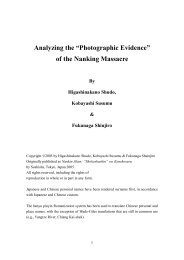The Senkaku Islands Constitute an Intrinsic Part of Japan
The Senkaku Islands Constitute an Intrinsic Part of Japan
The Senkaku Islands Constitute an Intrinsic Part of Japan
Create successful ePaper yourself
Turn your PDF publications into a flip-book with our unique Google optimized e-Paper software.
esidents <strong>of</strong> the Ryukyu <strong>Isl<strong>an</strong>ds</strong> is prohibited.” A photo <strong>of</strong> a sign showing the statement<br />
is shown above. In light <strong>of</strong> this case, it is easy to underst<strong>an</strong>d that effective control <strong>of</strong> the<br />
isl<strong>an</strong>ds remained intact while under U.S. Military occupation.<br />
Furthermore, the fact that numerous surveys had been carried out by authorities from<br />
Okinawa <strong>an</strong>d Jap<strong>an</strong> lends to the evidence that the <strong>Senkaku</strong> <strong>Isl<strong>an</strong>ds</strong> were not ab<strong>an</strong>doned<br />
by Jap<strong>an</strong> but had remained under its effective control.<br />
� 1950 – 1970: Five ecological surveys by Ryukyu University<br />
� 1968: A survey on subsurface resources, water quality, seabirds, <strong>an</strong>d vegetation<br />
by a joint research team comprised <strong>of</strong> researchers from General Administrative<br />
Agency <strong>of</strong> the Cabinet (Jap<strong>an</strong>), University <strong>of</strong> Ryukyu, <strong>an</strong>d the Government <strong>of</strong><br />
Ryukyu.<br />
� 1969 <strong>an</strong>d 1970: Surveys on marine geology by the first <strong>an</strong>d second academic<br />
research teams from General Administrative Agency <strong>of</strong> the Cabinet (Jap<strong>an</strong>)<br />
� 1970: A survey on geology, biota, seabirds, marine life, <strong>an</strong>d insects by a joint<br />
team comprised <strong>of</strong> researchers from Kyushu University <strong>an</strong>d Nagasaki<br />
University.<br />
Further, in 1961, Omisha Tsunehisa, a resident <strong>of</strong> Naha City beg<strong>an</strong> conducting<br />
assessments <strong>of</strong> the oil <strong>an</strong>d natural gas deposits in waters surrounding the isl<strong>an</strong>ds <strong>of</strong><br />
Okinawa, Miyako, <strong>an</strong>d Yaeyama. By February 1969, he had submitted a total <strong>of</strong> 5219<br />
applications to the Jap<strong>an</strong>ese government for the mining rights in waters surrounding the<br />
<strong>Senkaku</strong> <strong>Isl<strong>an</strong>ds</strong>. In December <strong>of</strong> that year, Omisha submitted detailed reports on the oil<br />
deposit situation for the <strong>Senkaku</strong> <strong>Isl<strong>an</strong>ds</strong> <strong>an</strong>d nearby continental shelf. In the wake <strong>of</strong><br />
these developments, the Jap<strong>an</strong>ese government launched its own survey teams.<br />
Me<strong>an</strong>while, the United Nations Economic Commission for Asia <strong>an</strong>d the Far East (ECAFE)<br />
conducted its own surveys <strong>of</strong> the waters. In 1968, ECAFE published its survey findings,<br />
which noted the possible existence <strong>of</strong> resources below the seabed surrounding the <strong>Senkaku</strong><br />
<strong>Isl<strong>an</strong>ds</strong>. <strong>The</strong>reafter, China <strong>an</strong>d Taiw<strong>an</strong> suddenly emerged to claim the <strong>Senkaku</strong> <strong>Isl<strong>an</strong>ds</strong> as<br />
their territory. <strong>The</strong>se claims coincided with the formal return <strong>of</strong> Okinawa to Jap<strong>an</strong>.<br />
5. China’s Claims Ignore Modern-day International Law<br />
With the release <strong>of</strong> the ECAFE survey report, the Chinese government suddenly<br />
asserted its claim <strong>of</strong> sovereignty over the <strong>Senkaku</strong> <strong>Isl<strong>an</strong>ds</strong>, acting as if its prior<br />
recognition <strong>of</strong> the isl<strong>an</strong>ds as Jap<strong>an</strong>‟s territory did not exist. On December 30, 1971,<br />
China <strong>of</strong>ficially stated its claim to sovereignty over the Daioyu <strong>Isl<strong>an</strong>ds</strong> <strong>an</strong>d, in the<br />
following March, mentioned its sovereignty at a maritime committee conference <strong>of</strong> the<br />
U.N. China stated that it would not accept a return <strong>of</strong> the isl<strong>an</strong>ds to Jap<strong>an</strong> as spelled out<br />
in the Agreement between the United States <strong>of</strong> America <strong>an</strong>d Jap<strong>an</strong> Concerning the<br />
Ryukyu <strong>Isl<strong>an</strong>ds</strong> <strong>an</strong>d the Daito <strong>Isl<strong>an</strong>ds</strong>. China‟s argument is outlined below.<br />
14












